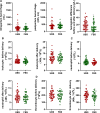Assessing the timing of amniotomy after Foley balloon catheter removal in women with labor induction: The role of Bishop score: An observational study
- PMID: 39705429
- PMCID: PMC11666173
- DOI: 10.1097/MD.0000000000041068
Assessing the timing of amniotomy after Foley balloon catheter removal in women with labor induction: The role of Bishop score: An observational study
Abstract
The timing of amniotomy after the Foley balloon catheter removal is crucial for successful labor induction. This study aimed to assess the effects of the Bishop score on the timing of amniotomy in patients undergoing labor induction after the Foley balloon catheter removal. This was a retrospective cohort study based on electronic medical records. We performed a Chester sampling in patients with singleton-term pregnancies who initially underwent cervical ripening using a Foley balloon catheter at the Obstetrical Department of Taixing People's Hospital from January 2023 to July 2023. A total of 889 patients were admitted to the study. After excluding 330 patients according to the exclusion criteria, 103 patients were included. Following the Foley balloon removal, an amniotomy with a Bishop score < 6 was defined as an amniotomy with an unfavorable Bishop score (n = 62), and an amniotomy with a Bishop score ≥ 6 was defined as an amniotomy with a favorable Bishop score (n = 41). The primary outcome was the incidence of cesarean delivery and the interval from induction to delivery. The secondary outcomes included the incidence of operative vaginal delivery, intrapartum hemorrhage, postpartum hemorrhage, infection, thrombosis, and neonatal outcomes. All statistical comparisons were analyzed by GraphPad Prism 9. All data were presented as the mean ± SD or percentage. Statistical analysis comparing both groups was performed using the t test, chi-square test, or Fisher exact test where appropriate. The baseline data, operative vaginal delivery rate, postpartum hemorrhage rate, infection rate, thrombosis rate, intrapartum and postpartum hemorrhage volume, and neonatal outcomes showed no significant differences between the 2 groups. However, the cesarean delivery rate, interval from induction to delivery, and hemoglobin postdelivery decline were significantly decreased in the favorable Bishop score group. Amniotomy with a favorable Bishop score after Foley balloon catheter removal is linked to lower cesarean delivery rates, shorter induction-to-delivery intervals, and less postdelivery hemoglobin decline without increasing adverse maternal or neonatal outcomes.
Copyright © 2024 the Author(s). Published by Wolters Kluwer Health, Inc.
Conflict of interest statement
The authors have no conflicts of interest to disclose.
Figures


Similar articles
-
Cervical balloon catheter vs Dilapan-S for outpatient cervical ripening: a randomized controlled trial.Am J Obstet Gynecol MFM. 2025 Jun;7(6):101608. doi: 10.1016/j.ajogmf.2025.101608. Epub 2025 Jan 14. Am J Obstet Gynecol MFM. 2025. PMID: 39818274 Clinical Trial.
-
Membrane sweeping versus transcervical Foley catheter for induction of labor in women with a previous cesarean delivery: a randomized controlled trial.Minerva Obstet Gynecol. 2025 Jun;77(3):157-165. doi: 10.23736/S2724-606X.24.05470-8. Epub 2024 Dec 3. Minerva Obstet Gynecol. 2025. PMID: 39625419 Clinical Trial.
-
Maternal and neonatal outcomes of elective induction of labor.Evid Rep Technol Assess (Full Rep). 2009 Mar;(176):1-257. Evid Rep Technol Assess (Full Rep). 2009. PMID: 19408970 Free PMC article.
-
Methods for assessing pre-induction cervical ripening.Cochrane Database Syst Rev. 2015 Jun 12;2015(6):CD010762. doi: 10.1002/14651858.CD010762.pub2. Cochrane Database Syst Rev. 2015. PMID: 26068943 Free PMC article.
-
Methods of term labour induction for women with a previous caesarean section.Cochrane Database Syst Rev. 2017 Jun 9;6(6):CD009792. doi: 10.1002/14651858.CD009792.pub3. Cochrane Database Syst Rev. 2017. PMID: 28599068 Free PMC article.
References
-
- Jamaluddin A, Azhary JMK, Hong JGS, Hamdan M, Tan PC. Early versus delayed amniotomy with immediate oxytocin after Foley catheter cervical ripening in multiparous women with labor induction: a randomized controlled trial. Int J Gynaecol Obstet. 2023;160:661–9. - PubMed
-
- Appadurai U, Gan F, Hong J, Hamdan M, Tan PC. Six compared with 12 hours of Foley balloon placement for labor induction in nulliparous women with unripe cervices: a randomized controlled trial. Am J Obstet Gynecol MFM. 2023;5:101157. - PubMed
-
- Wheeler V, Hoffman A, Bybel M. Cervical ripening and induction of labor. Am Fam Physician. 2022;105:177–86. - PubMed
-
- Stolyar S, Marx CJ. Align to define: ecologically meaningful populations from genomes. Cell. 2019;178:767–8. - PubMed
Publication types
MeSH terms
Grants and funding
LinkOut - more resources
Full Text Sources

